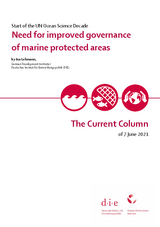Start of the UN Ocean Science Decade
Need for improved governance of marine protected areas
Lehmann, InaThe Current Column (2021)
Bonn: German Development Institute / Deutsches Institut für Entwicklungspolitik (DIE), The Current Column of 7 June 2021
Marine and coastal ecosystems are a vital source of food for humans and can provide important protection against threats such as floods and storms – not least in a context of global climate change. And yet, marine biodiversity is under enormous pressure, threatening the continued provisions of its contributions to people’s livelihoods. Estimates by the International Union for Conservation of Nature suggest, for instance, that 36% of assessed species of sharks and rays and 33% of assessed species of reef corals face extinction. In order to strengthen the knowledge base for ocean protection, the United Nations launched the Decade of Ocean Science for Sustainable Development on June 1. This knowledge should inter alia inform existing international frameworks for protecting the ocean. Among them is the Convention on Biological Diversity (CBD), which is the most comprehensive agreement for the conservation of global biodiversity. Its parties are expect to adopt a ten-year Global Biodiversity Framework this October. It provides a boost to the expansion of marine protected areas as a key approach to marine biodiversity protections. In the light of persistent challenges to the effectiveness and justice of marine protected areas, there is an urgent need to gain an improved understanding of the guiding principles for the better governance of marine protected areas.
Protected areas are a traditional cornerstone of conservation policies under the CBD. Marine protected areas in particular have grown over the past 20 years. The CBD’s most recent 2011-2020 strategic framework foresaw that ‘at least (…) 10 per cent of coastal and marine areas’ be conserved by 2020 through protected areas or other effective area-based conservation mechanisms (OECMs). The latter are measures that are not legally declared as protected areas and may not have conservation as their declared primary objective, but still fulfil related functions. According to the 5th Global Biodiversity Outlook, about 7.5 % of marine areas were covered by protected areas in August 2020. These numbers are presumably higher when taking OECMs into account. A major expansion of marine protected areas has only come in the past two decades, with an almost tenfold increase in the area covered by them between 2000 and 2020. The zero draft of the prospective new Global Biodiversity Framework foresees an expansion to 30 % of marine areas being conserved via protected areas or OECMs.
There is, nevertheless, mixed evidence for effective conservation of marine biodiversity through protected areas. Marine protected areas can deliver significant benefits for biodiversity inside them, for example through protection of habitat structure, species stocks and diversity, and ecological processes. They can also foster biomass spillover outside their boundaries. However, the establishment of a protected area does not automatically result in the protection of the most threatened species. On the contrary, there are numerous examples of protected areas in remote or inaccessible locations far from coastlines that are not of major interest for extractive economic activities. A recent trend towards very large marine protected areas increases the challenges of monitoring and enforcing them. Moreover, current marine protected areas are only partially representative of the diversity of global marine ecosystems. Many of the most relevant areas for marine biodiversity remain without formal protection. Accordingly, in many cases the establishment of protected areas has made little difference to the environmental status quo.
In addition, the social justice implications of marine protected areas – when they are established in areas of regular human activity – have also raised concerns. Resource use restrictions in protected areas frequently imply livelihood losses and cultural restrictions for local populations who are alienated from their previous occupation and related traditions. In the Global South in particular, examples include the displacement of local fishing communities from their traditional fishing grounds. In many cases, indigenous peoples and local communities who are most directly affected by restrictions are the least responsible for marine biodiversity loss, which results primarily from industrial fishing and aquaculture, coastal infrastructure projects, intensive agriculture and so on.
So while the envisaged increase in marine protected areas may initially look like a promising rise in attention to marine biodiversity, the quality of governance and implementation will be much more important than just enlarging the total area covered. The challenges to effectiveness and justice of marine protected areas are well documented. The UN Ocean Decade is a timely opportunity to foster understanding of the pathways for transforming badly governed marine protected areas into ones that are effective and socially just.


